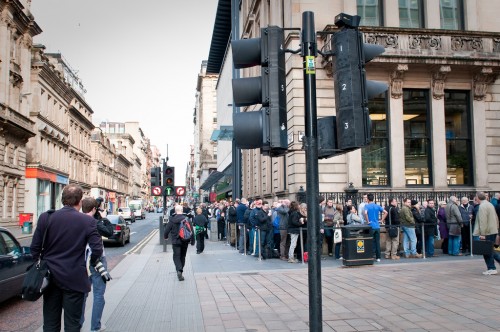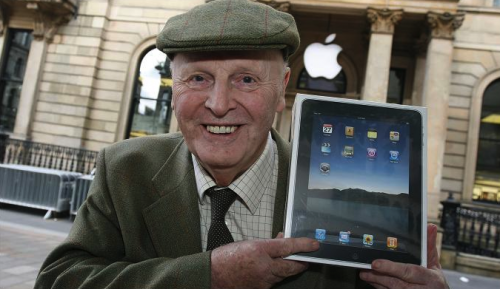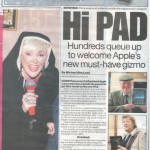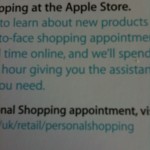Friday May 28th. This was the day of the iPad launching internationally. Initially I wasn’t sure about picking up an iPad. Shakeel was even more doubtful. We’d seen the reviews but how useful would it be? Is it really that fast and usable? Then a couple of weeks ago at our talk at Glasgow MUG we finally saw an iPad in the flesh. That cemented it for me that the iPad was a buy I wanted to make. My MacBook Pro also broke which meant I had no portable device for the essential surfing and tweeting in front of the TV. So for the last few days we debated what size and whether it should be wifi only or 3G. Size was easily settled when I started downloading app’s on Wednesday evening – some were huge!
So it was a cold morning in Glasgow when we joined the queue at the Apple store. There looked to be around 50 odd people and this was around 06:30 which was more than I expected. It wasn’t long after that the Apple staff started walking around letting us know the first 50 would go into the store and they would be assigned a personal shopper who would help us to buy the iPad, accessories and sims. Say what you will about Apple but they definitely know how to launch a product.
With the help of a Starbucks or two the time passed quite quickly. With five minutes to go the Apple staff did a run around the block whooping and a cheering. Fair play – it did help to build a bit of excitement but rather them than me. Then at 08:00 the doors were opened and we trooped in. Thankfully we were in the first 50 so got some heat. I was surprised how quickly people were served and we were both out of the store by 08:30 with our 64GB 3G iPads. I should note that the buying experience was pretty unique. We were brought into the store and each customer got an individual personal shopper who introduced themselves, asked what we were looking for, ran around (literally) to pick up any accessories we may have wanted and them completed the purchase. No hard sell of insurances, add-ons etc. A big well done the the team at Glasgow Apple store as it looked to go incredibly smoothly.
Thinking back to the queue, one aspect that stood out was variety. If you’d ask me who’d be there on a crisp May morning I would have guessed male 20-30 year olds, not all wearing black turtlenecks, but not far off. The age range was massive and demonstrates why Apple is so successful. A computer and eco-system oft criticised as being closed and restrictive but to the majority of end users that doesn’t matter – the Apple platform is easy to use and the hardware is some of the best designed in the industry. Not only that, everyone knows someone that has an iPod. One chap that stood out was an elderly gent wearing a cap not disimilar to one that Shak frequently wears. We saw him pass by but it was only when we were inside the store that we realised he was queuing for an iPad. Maybe for a relative or grandchild?
No. It turns out the chap, William Boyd, was buying his first computer – an iPad. At the grand old age of 78 he wanted an iPad for internet, e-mails and things like that. Main reason for choosing the iPad – simplicity. Great story and one that sums up Apple’s popularity. There’s products aren’t for everyone but they appeal to a broader base than any other tech company.
Another aspect of the shopping experience – Apple store employees were more than happy to pass you on to an expert who would take you through the setup of your iPad, how to use it and how to get the best out of it. You don’t get that at PC World (although you could also buy the iPad on launch day from there if you wanted). I declined as I wouldn’t get to play with the iPad for another 12 hours or so due to a works outing. Thankfully we did take a holiday on Friday as our photo appeared in many papers on Friday and Saturday. Geek fame. By all accounts sales were pretty brisk in the UK which I didn’t really expect. Also surprised that 3G models seem to be most popular.
So after the queuing and waiting the big question – how good is the iPad? In the last 48 hours I’ve tried to do as much on it as possible, including crafting this blog post. It’s a remarkable device and those that say “it’s a big iPod touch” either haven’t used one or don’t get it. Speed, battery life and portability coupled with a great screen and a fantastic line up of app’s at launch make for a superb experience. There are many cons which we’ll cover in the next post but there are two thoughts that I have today which I didn’t expect. One is that the iPad and a desktop computer are a combination that works really well for me – no laptop required. Second – the next iPhone isn’t the guaranteed purchase that I’d originally budgeted for.








